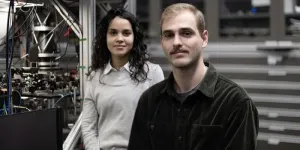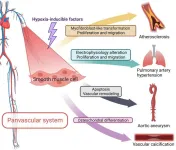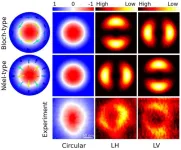(Press-News.org) EMBARGOED by JAMA Neurology until 11 a.m. EDT Aug. 28, 2023
Contact: Maria Ober, 617-224-8963, mpober@bu.edu
(Boston)— A new BU Chronic Traumatic Encephalopathy (CTE) Center study has found that, among a sample of 152 young athletes exposed to repetitive head impacts (RHI) who were under age 30 at the time of death, 41.4% (63) had neuropathological evidence of CTE, a degenerative brain disease caused by RHI. The study published in JAMA Neurology includes the first American woman athlete diagnosed with CTE, a 28-year-old collegiate soccer player whose identity remains private.
“This study clearly shows that the pathology of CTE starts early,” said corresponding author Ann McKee, MD, chief of neuropathology at VA Boston Healthcare System and director of the BU CTE Center. “The fact that over 40% of young contact and collision sport athletes in the UNITE brain bank have CTE is remarkable - considering that studies of community brain banks show that fewer than 1% of the general population has CTE.”
Nearly all the young athletes had mild CTE, stages 1 and 2; 3 donors had CTE stage 3. (There are 4 possible stages of CTE with stage 4 being the most severe). In those with CTE, there was often other evidence of brain injury, including the presence of a cavum septum pellucidum, enlargement of the ventricles, and more perivascular macrophages in the white matter.
Clinical symptoms were common among the athletes, whether or not they had CTE. Clinical symptoms included depression (70.0%), apathy (71.3%), difficulty controlling behaviors (56.8%), and problems with decision making (54.5%). Substance abuse also was frequent, with alcohol abuse present in 42.9% and drug abuse in 38.3%.
“The study suggests that some of the symptoms these young athletes are experiencing are not caused by the early tau pathology of CTE,” said McKee. “It is imperative that young athletes who are experiencing neuropsychiatric symptoms seek out care, as it is likely that the symptoms can be reduced with effective management and follow-up.”
Amateur athletes comprised 71.4% of those diagnosed with CTE, and included American football, ice hockey, soccer and rugby players, and wrestlers. Those diagnosed with CTE were older (average age at death 25.3 years vs. 21.4) and had significantly more years of exposure to contact sports (11.6 vs 8.8 years).
Like all brain bank studies, the brain donors are different from the general population of young athletes, in part because they are more likely to have symptoms. CTE cannot yet be diagnosed in the living, and the true prevalence of CTE in any population remains unknown.
“This study highlights the importance of assessing the symptoms and clinical presentation of CTE in living athletes who have sustained repetitive head injuries,” said Nsini Umoh, PhD, program director for traumatic brain injury (TBI) research at the National Institute of Neurological Disorders and Stroke (NINDS), which contributed funding to the study. “While additional research in this area is needed, these findings are a notable addition to the body of research on CTE.”
Further needed research includes analyzing young brain donors not exposed to contact and collision sports, to better understand non-CTE brain damage from RHI, and what symptoms are related to concussions, RHI, and CTE.
McKee and colleagues recently developed the first CTE Prevention Protocol, a series of evidence-based recommendations to help sports organizations develop policies, alongside their existing concussion protocols, to reduce CTE risk. Athletes with symptoms from concussions or concerned about CTE can reach out to the Concussion Legacy Foundation HelpLine. For more information about the BU CTE Center, the UNITE brain bank, and CTE, please visit us at www.bu.edu/cte.
We thank the generous supporters and funding sources: The Department of Veterans Affairs, NINDS and NIA, part of NIH, the Buoniconti Foundation and the Mac Parkman Foundation. To contribute, please click here.
END
BU CTE Center publishes largest CTE case series ever in youth, high school and college athletes who died young
Study details more than 60 cases of CTE diagnosed in athletes under age 30, including first American woman soccer player diagnosed with CTE
2023-08-28
ELSE PRESS RELEASES FROM THIS DATE:
NIH study shows association between better neighborhood conditions and lower childhood asthma rates
2023-08-28
Living in a neighborhood with better access to resources such as high-quality housing, healthy food, parks and playgrounds, and clean air during the early stages of childhood was associated with lower asthma incidence in a new study from NIH’s Environmental influences on Child Health Outcomes (ECHO) Program.
Children born in high-opportunity neighborhoods had an asthma incidence rate of 23.3 cases per 1,000 children, while those born in very low and low-opportunity neighborhoods had rates of 35.3 per 1,000 ...
Scientists use quantum device to slow down simulated chemical reaction 100 billion times
2023-08-28
Scientists at the University of Sydney have, for the first time, used a quantum computer to engineer and directly observe a process critical in chemical reactions by slowing it down by a factor of 100 billion times.
Joint lead researcher and PhD student, Vanessa Olaya Agudelo, said: “It is by understanding these basic processes inside and between molecules that we can open up a new world of possibilities in materials science, drug design, or solar energy harvesting.
“It could also help improve ...
Assessment of hospital-onset SARS-CoV-2 infection rates and testing practices
2023-08-28
About The Study: In this study of hospitals reporting SARS-CoV-2 infections, there was an increase of hospital-onset SARS-CoV-2 infections when community-onset infections were higher, indicating a need for ongoing and enhanced surveillance and prevention efforts to reduce in-hospital transmission of SARS-CoV-2 infections, particularly when community-incidence of SARS-CoV-2 infections is high.
Authors: Kelly M. Hatfield, M.S.P.H., of the Centers for Disease Control and Prevention in Atlanta, is the ...
Trends in suicide rates among post-9/11 veterans with and without traumatic brain injury
2023-08-28
About The Study: In a large cohort of U.S. military veterans serving after 9/11, suicide rates increased more than 10-fold from 2006-2020, a significantly greater rate of change than in the U.S. adult population. Over the 15-year period, veterans with traumatic brain injury (TBI) had suicide rates 56% higher than veterans without TBI and three times higher than the U.S. adult population.
Authors: Jeffrey T. Howard, Ph.D., of the University of Texas at San Antonio, is the corresponding author.
To access the embargoed study: Visit our For The Media website at this link https://media.jamanetwork.com/
(doi:10.1001/jamaneurol.2023.2893)
Editor’s ...
Estimated lifetime gained with cancer screening tests
2023-08-28
About The Study: The findings of this systematic review and meta-analysis of 18 long-term randomized clinical trials involving 2.1 million individuals suggest that current evidence does not substantiate the claim that common cancer screening tests save lives by extending lifetime, except possibly for colorectal cancer screening with sigmoidoscopy.
Authors: Michael Bretthauer, M.D., Ph.D., of the University of Oslo in Oslo, Norway, is the corresponding author.
To access the embargoed study: Visit our For The Media website at this link https://media.jamanetwork.com/
(doi:10.1001/jamainternmed.2023.3798)
Editor’s ...
Neuropathologic and clinical findings in young contact sport athletes exposed to repetitive head impacts
2023-08-28
About The Study: This case series found that young brain donors exposed to repetitive head impacts were highly symptomatic regardless of chronic traumatic encephalopathy (CTE) status, and the causes of symptoms in this sample are likely multifactorial. Future studies that include young brain donors unexposed to repetitive head impacts are needed to clarify the association among exposure, white matter and microvascular pathologic findings, CTE, and clinical symptoms.
Authors: Ann C. McKee, M.D., of the U.S. Department of Veteran Affairs in Boston, is the corresponding author.
To access the embargoed study: Visit our For The Media website ...
Due to sea-ice retreat, zooplankton could remain in the deep longer
2023-08-28
Due to intensifying sea-ice melting in the Arctic, sunlight is now penetrating deeper and deeper into the ocean. Since marine zooplankton respond to the available light, this is also changing their behaviour – especially how the tiny organisms rise and fall within the water column. As an international team of researchers led by the Alfred Wegener Institute has now shown, in the future this could lead to more frequent food shortages for the zooplankton, and to negative effects for larger species including seals and whales. The study ...
Hypoxia and panvascular diseases: exploring the role of hypoxia-inducible factors in vascular smooth muscle cells under panvascular pathologies
2023-08-28
This study is led by Prof. Junbo Ge (Department of Cardiology, Zhongshan Hospital, Fudan University, Shanghai Institute of Cardiovascular Diseases), Prof. Hua Li (Department of Cardiology, Zhongshan Hospital, Fudan University, Shanghai Institute of Cardiovascular Diseases), and Prof. Hao Lu (Department of Cardiology, Zhongshan Hospital, Fudan University, Shanghai Institute of Cardiovascular Diseases).
As an emerging concept, panvascular diseases encompass a group of cardiovascular disorders characterized mainly by atherosclerosis, involving crucial organs such as the ...
Spintronics: X-ray microscopy unravels the nature of domain walls
2023-08-28
Magnetic skyrmions are tiny vortices-like of magnetic spin textures that - in principle - can be used for spintronic devices, for example very fast and energy-efficient data storage devices. But at the moment it is still difficult to control and manipulate skyrmions at room temperature. A new study at BESSY II analyses the formation of skyrmions in ferrimagnetic thin films of dysprosium and cobalt in real time and with high spatial resolution. This is an important step towards characterising suitable materials with skyrmions more precisely in the future.
Isolated magnetic skyrmions are topologically protected spin textures that are in the focus of research ...
World first drug to target form of previously untreatable life-threatening ‘bad cholesterol’
2023-08-28
A new drug offers a breakthrough world first treatment for Lipoprotein(a), a largely genetic form of cholesterol that increases the risk of heart attack and stroke, announced today by study lead Professor Stephen Nicholls, Director of the Monash University’s Victorian Heart Institute and Victorian Heart Hospital.
High levels of Lipoprotein(a), known as Lp(a) or spoken as ‘LP little a’, impact one in five people globally with no approved treatment currently on the market.
The trial demonstrated the success of Muvalaplin - the first oral drug ever ...
LAST 30 PRESS RELEASES:
Heart-brain connection: international study reveals the role of the vagus nerve in keeping the heart young
Researchers identify Rb1 as a predictive biomarker for a new therapeutic strategy in some breast cancers
Survey reveals ethical gaps slowing AI adoption in pediatric surgery
Stimulant ADHD medications work differently than thought
AI overestimates how smart people are, according to HSE economists
HSE researchers create genome-wide map of quadruplexes
Scientists boost cell "powerhouses" to burn more calories
Automatic label checking: The missing step in making reliable medical AI
Low daily alcohol intake linked to 50% heightened mouth cancer risk in India
American Meteorological Society announces Rick Spinrad as 2026 President-Elect
Biomass-based carbon capture spotlighted in newly released global climate webinar recording
Illuminating invisible nano pollutants: advanced bioimaging tracks the full journey of emerging nanoscale contaminants in living systems
How does age affect recovery from spinal cord injury?
Novel AI tool offers prognosis for patients with head and neck cancer
Fathers’ microplastic exposure tied to their children’s metabolic problems
Research validates laboratory model for studying high-grade serous ovarian cancer
SIR 2026 delivers transformative breakthroughs in minimally invasive medicine to improve patient care
Stem Cell Reports most downloaded papers of 2025 highlight the breadth and impact of stem cell research
Oxford-led study estimates NHS spends around 3% of its primary and secondary care budget on the health impacts of heat and cold in England
A researcher’s long quest leads to a smart composite breakthrough
Urban wild bees act as “microbial sensors” of city health.
New study finds where you live affects recovery after a hip fracture
Forecasting the impact of fully automated vehicle adoption on US road traffic injuries
Alcohol-related hospitalizations from 2016 to 2022
Semaglutide and hospitalizations in patients with obesity and established cardiovascular disease
Researchers ‘listen in’ to embryo-mother interactions during implantation using a culture system replicating the womb lining
How changing your diet could help save the world
How to make AI truly scalable and reliable for real-time traffic assignment?
Beyond fragmented markets: A new framework for efficient and stable ride-pooling
Can shape priors make road perception more reliable for autonomous driving?
[Press-News.org] BU CTE Center publishes largest CTE case series ever in youth, high school and college athletes who died youngStudy details more than 60 cases of CTE diagnosed in athletes under age 30, including first American woman soccer player diagnosed with CTE




